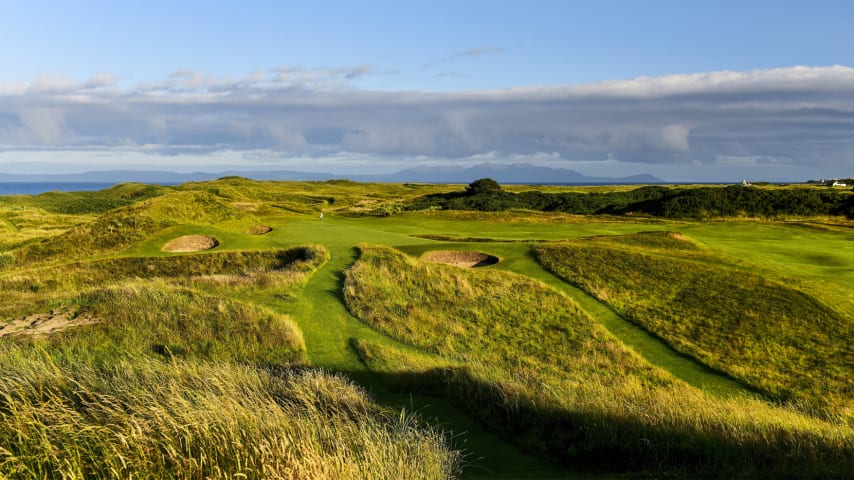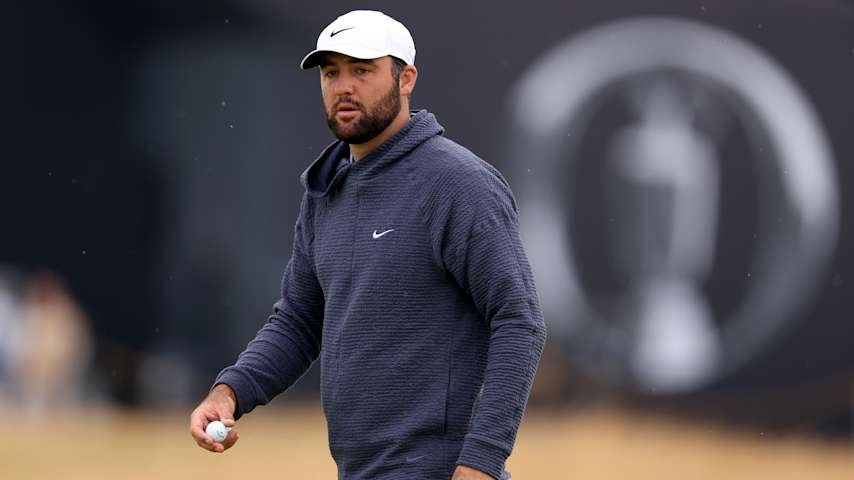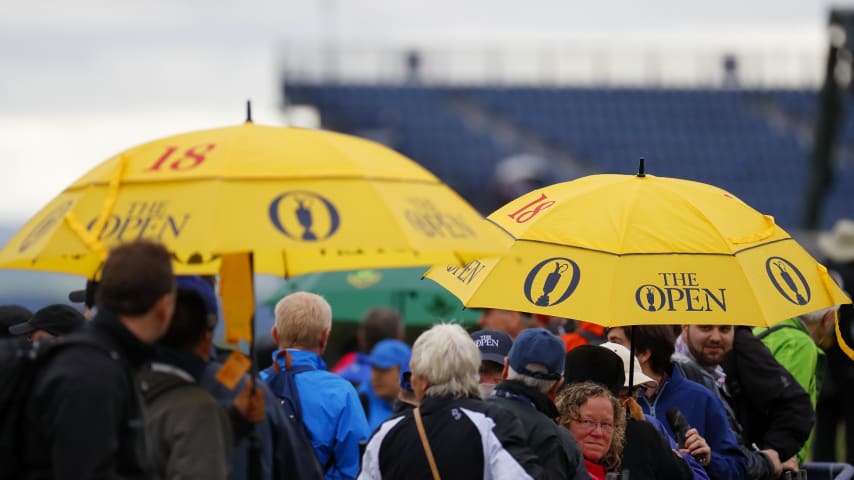Nine things to know: Royal Troon
13 Min Read

Leonard, Montgomerie break down Royal Troon prior to The Open Championship
Written by Bradley S. Klein
Golf’s oldest major is returning this week to a treasured venue for its 152nd edition. This marks The Open Championship’s 10th time visiting Royal Troon, and it comes 101 years after the tournament was first played there. World Golf Hall of Famers Arnold Palmer, Tom Watson and Tom Weiskopf are among the champions at Royal Troon, which is best known for the tiny, but treacherous, Postage Stamp par 3.
Before The Open gets underway, here are nine things you need to know about the course.
1. The Ayrshire Coast
Royal Troon is situated on Scotland’s west coast, on the far side of Glasgow. While not as well known as Scotland’s East Lothian, this region still offers some of the game’s richest links.
Troon is located along the sandy, windswept coast of the Firth of Clyde, a large bay framed by Northern Ireland to the south and the Kintyre Peninsula to the north that opens up to the North Atlantic. Royal Troon is at the midpoint of a 21-mile stretch of shorefront dunes land that includes such wonderful layouts as Prestwick, St. Nicholas, Western Gailes, Dundonald Links, Gailes Links, Irvine GC and West Kilbride.
2. Its evolution
Royal Troon is now a 45-hole private club that abuts an active commuter train line on its eastern flank. It occupies the crumpled, sandy dunes land between the shoreline and what used to be farmland, and its ninth green is only 600 yards from the main runway at Glasgow Prestwick Airport.

A look at the first hole at Royal Troon. (David Cannon/Getty Images)
Royal Troon has evolved from an initial six-hole layout designed in 1878 by Old Tom Morris protégé Charlie Hunter. Six years later, it was expanded to 18 holes by club professional George Strath. A major refinement came in 1910 at the hands of 1883 Open Champion Willie Fernie, whose work created the current routing and what quickly became two of the course’s most famous holes, the Postage Stamp par-3 eighth, and the par-4 11th hole known as “Railway” because of its proximity to the rail line, which forms an uncomfortably-close boundary. Royal Troon’s Old Course derived much of its more demanding bunkering and playing character in 1922 through an extensive renovation by five-time Open Champion and (future) World Golf Hall of Famer James Braid. That came a year before Troon hosted its first Open, which saw England’s Arthur Havers upset defending champion Walter Hagen by one shot.
The club’s other 18-hole layout, the Portland Course, circulates inland, to the east and south, and owes its present routing to a fresh 1921 design by Alister MacKenzie, another World Golf Hall of Famer. The club also has a nine-hole, par-3 layout called Craigend. Troon’s main clubhouse, aligned immediately behind the 18th hole of the Old Course on a perpendicular axis, is a classic stone Victorian structure designed in 1888 by Glasgow-based building architect Henry Edward Clifford. The club received its “royal” designation as part of its centenary celebration in 1978.
3. Three in one
The Old Course at Royal Troon offers a variety of experiences in a single round.
It’s best to get ahead early at Royal Troon, then simply hang on for dear life. The first six holes play downwind over crumpled terrain, and the opening trio consists of three short par 4s all under 400 yards.
Two of the next three holes are par 5s that play downwind, usually reachable in two despite measuring 599 yards and 623 yards, respectively.
The next six holes, by contrast, amble through sand dunes and steeper terrain at the far end of the golf course. The start of the back nine presents two of the hardest long par- s in championship golf, thanks to narrow fairways, a prevailing headwind from the left and out-of-bounds close in on the right. Things don’t get much easier for the final six holes, a brutal finish that continues the trek into the breeze. The par-3 17th measures more than 240 yards, with players hitting long irons (or more) to a tabletop green. The finishing hole, which measures nearly 460 yards, features a heavily bunkered fairway.
The five par 4s on the front nine have an average length of 393 yards; on the back nine, the six par 4s average 472 yards – a 79-yard gap that’s exacerbated by the fact that many of them play into the wind.
“From the 10th tee onwards, it's a long way home,” said Colin Montgomerie, a longtime Royal Troon member.
4. A new look
British golf designer Martin Ebert has been Royal Troon’s consulting architect for more than two decades. It's a role he holds at several other Open rota courses, including Turnberry, Royal Portrush, Carnoustie, Royal Lytham & St. Annes, Royal St. George’s, Royal Birkdale and Royal Liverpool.
For this year’s Open Championship, Ebert’s edits included a half-dozen back tees that added 201 yards to the course. The three par 5s have all been lengthened. The course has been lengthened 2.8% since it last hosted The Open eight years ago, which corresponds exactly to the additional 2.8% of distance the average PGA TOUR player has gained in that span.
Some modest bunkering was added to the landing areas on several holes, as well. Along the way, the club’s nine-hole, par-3 course, Craigend, was dramatically redesigned. It also was moved to find higher, drier ground and provide target greens for the temporary practice range for The Open.
Royal Troon spectator infrastructure has also been expanded to accommodate an expected 250,000 spectators for the week – as many as 45,000-50,000 per day during the championship rounds. The viewing stands feature 13,300 seats, the largest of which will overlook the 18th fairway. That grandstand will hold more than 4,000 people.
Course superintendent Billy McLachan will have his full crew of 38 at the ready, supplemented by a dozen other staff and volunteers from the R&A and other clubs.
5. Postage Stamp
Royal Troon’s shortest hole also is its most famous.
The par-3 eighth is only 123 yards long, the shortest of any hole in The Open rota. From a platform tee above sandy broken ground, golfers target a tiny green that’s just 2,500 square feet.

A look at the eighth hole at Royal Troon, originally known as ‘Ailsa’ in tribute to the rock out to sea. (David Cannon/Getty Images)
The small pedestal of a putting surface is framed by five intensely deep bunkers and steep slopes of short grass that repel mishits. The hole heads due west, with the prevailing wind coming in from the player’s right. It is usually the first shot of the day that a player is hitting into the wind, and the short approach requires him to control both his distance and trajectory. On a calm day, the hole requires nothing more than a wedge. The wind can necessitate a mid-iron, however.
“You're playing downwind for seven holes then you have to turn around and hit off this elevated tee to this green that looks like the size of this table into the wind,” said Justin Leonard, who won the 1997 Open at Royal Troon.
Gene Sarazen was 71 years old when he aced the hole in the 1973 Open Championship (he holed a bunker shot for birdie the following day, playing the hole in three strokes for the two rounds he played that week).
“For many years, the Postage Stamp hole had haunted me,” Sarazen once told the Palm Beach Post. “When the clubhead came into contact with the ball, I had the same feeling when I had my double-eagle (at Augusta National) in 1935. When the crowd roared I realized that the ball was in the hole. I knew there was no better way to close the books on my tournament play.”
Herman Tissies made a 15 on the hole in 1950, needing 12 strokes to get out of a greenside bunker.
No. 8 even derailed Tiger Woods in his first Open as a professional. He was making a serious final-round charge after a Saturday 64 vaulted him into contention, but he overshot the green and made a triple bogey.
The short hole played slightly over par in 2016, with the field averaging 3.1 strokes. Despite not having any water, it played slightly more difficult than TPC Sawgrass’ island-green 17th that year (3.09 to 3.02).
"When the wind is rollicking in from the sea, as it so often is, this is scarcely a hole for the chap whose nerves are fidgety,” George Trevor wrote in the Brooklyn Daily Eagle back in 1923. It still holds true today.
6. Railway
While the Postage Stamp can befuddle players in more subtle ways, Royal Troon’s 11th hole hits them with a show of brute strength.
The 490-yard par 4 plays even longer because of the prevailing wind, and thick gorse and out-of-bounds wait on each side of the fairway to deliver a harsh penalty. This hole, nicknamed “Railway,” is among the most difficult at any Open venue.

A look at the fourth hole at Royal Troon, the first of three par five holes. (David Cannon/Getty Images)
Stretched to its limit with a back tee hard against the eastern boundary wall that separates the golf course from the train tracks, the hole heads straight northwest into the teeth of the wind.
At the tee shot landing zone some 300 yards away, the fairway starts to narrow down from 35 yards to 28. The out-of-bounds stakes along the rail line are just 20 yards from the fairway’s right side.
The tracks are even tighter to the right side of the green, but players who shy away from them must contend with a deep pot bunker that guards the green’s front-left corner. The slightest imprecision in ball striking is grievously punished, such as in the first round of The Open in 1962 at Troon, when defending U.S. Open champion Jack Nicklaus took a 10 here on his way to an 80.
The hole played to a 4.6 scoring average in 2016, making it the hardest hole on the PGA TOUR that year.
7. A long history
Troon has been quite the stage through nine Open Championships. The first one in 1923, saw Englishman Arthur Havers prevail over defending champion Hagen by a single stroke. Hagen went on to win the 1924 Open Championship, and then two more (1928, ’29).
Perhaps the biggest surprise of that first Open at Royal Troon, however, was the fact that 1922 U.S. Open champion Gene Sarazen failed in final qualifying to make the championship at all; in those days, having just won a major did not spare you from having to play your way into the championship just like everybody else.
South Africa’s Bobby Locke won his second consecutive Open Championship in 1950 at Royal Troon, winning what would become the second of four claret jugs he claimed in his remarkable career. With his flat cap, plus-fours, hickory shafted putter, and at times painfully slow play, he was a powerful presence on the course. His win at Troon came during a streak from 1947 through 1950 that saw him win 11 times in 59 appearances on the PGA TOUR.
When The Open returned to Royal Troon 12 years later, fans saw another Hall of Famer successfully defend his title. Arnold Palmer won the 1962 Open a year after claiming the claret Jug at Royal Birkdale. Massive crowds cheered Palmer as he dominated Troon with a winning total of 12 under par, six shots better than runner-up Kel Nagle. (Palmer lost to Nagle by a shot two years earlier at St. Andrews, halting Palmer’s bid for the Grand Slam after he won that year’s Masters and U.S. Open).
Having convinced fellow American pros to join him in playing the event, Palmer’s presence gave a powerful boost to the championship and to the whole business of British golf in general.
Tom Weiskopf’s win in the 1973 Open Championship at Troon came in the middle of a torrid nine-week stretch that saw him win five times – at Colonial, Charlotte, Memphis, The Open and the RBC Canadian Open. It was the lone major championship for Weiskopf, who was inducted into the World Golf Hall of Fame this year.
Nobody carried the weight of more expectations into the Open Championship in 1982 than a young Bobby Clampett. And after rounds of 67-66 (11 under par), he held a five-shot lead going into the third round. It appeared those high hopes for the 22-year-old would be validated. But rounds of 78-77 on the weekend brought him tumbling back to earth. Clampett was never the same, and Tom Watson won to continue his incredible record in The Open. By successfully defending the next year, Watson completed a remarkable nine-year stretch that saw him win five Open Championships.
8. Recent opens
Mark Calcavecchia added another chapter to Greg Norman’s major letdowns by beating him in a four-hole aggregate playoff in 1989 (Australia’s Wayne Grady, who’d go on to win the 1990 PGA, also was in the playoff). Calcavecchia holed a 50-foot par putt on the 11th hole, then birdied 18 to join the playoff.
Norman shot a course-record 64 in the final round, which looked like it would be enough to overcome a seven-shot deficit to Grady, the 54-hole leader. Not even two birdies by Norman on the playoff’s opening two holes could secure a win, in large measure due to a disastrous final hole (the 18th) that saw him pick up without finishing after finding two bunkers and hitting his third shot out-of-bounds into the clubhouse area.
Justin Leonard was one of the game’s young stars when he won the 1997 Open Championship at 25 years old. He won the U.S. Amateur, NCAA Championship and had two wins apiece in the Western and Southern amateurs during his decorated amateur career. He won twice on the PGA TOUR before arriving at Royal Troon, as well.
A final round 65 closed a five-shot deficit behind Sweden’s Jesper Parnevik, who ended up in second place, three shots back, with Northern Ireland’s Darren Clarke.
Todd Hamilton was still glowing in the aura of his first PGA TOUR win at The Cognizant Classic in The Palm Beaches earlier that season when he came to Royal Troon in 2004 for the Open Championship. He consistently recovered greenside with pars by chipping with a hybrid 3-wood and won a four-hole aggregate playoff with South Africa’s Ernie Els.
The Open Championship in 2016 saw Royal Troon stage an epic final round, final pairing showdown between Phil Mickelson and Sweden’s Henrik Stenson. Shot for shot, birdie for birdie, they parried each other’s shot making down the stretch, with Stenson’s 63 besting Mickelson’s 65 and tying the record for lowest-ever major score. That left Stenson at a major championship record 20-under par, one better than Mickelson and an amazing 14 shots better than third-place finisher J.B. Holmes.
9. What to watch for
Watching on TV at home, the impact of an Open Championship played on a true links course can be very strong, if at times controversial. The grass is browned out, the bounces wild and seemingly unfair at times, the wind is always a major factor, and the natural setting becomes part of the charm and the mystique of a round rather than a simple frame or background. These are all takeaways that could enhance one’s appreciation of golf at one’s home course considerably.
Golf aesthetics are a tricky thing. For those accustomed to a lush green landscaped lawn, Royal Troon will take some getting used to. But as Martin Ebert says, Royal Troon “has a special quality to it, due as much to the strength of its holes as to its natural setting.”
Small wonder the club carefully metes out its guest tee times. A round here is a treasured component of any Scottish golf journey.
Royal Troon Golf Club – Old Course
| Hole | Par | Yardage | Name |
| 1 | 4 | 366 | Seal |
| 2 | 4 | 380 | Black Rock |
| 3 | 4 | 376 | Gyaws |
| 4 | 5 | 599 | Dunure |
| 5 | 3 | 220 | Greenan |
| 6 | 5 | 623 | Turnberry |
| 7 | 4 | 403 | Tel-el-Kebir |
| 8 | 3 | 123 | Postage Stamp |
| 9 | 4 | 440 | The Monk |
| 36 | 3,530 | ||
| 10 | 4 | 450 | Sandhills |
| 11 | 4 | 498 | Railway |
| 12 | 4 | 451 | The Fox |
| 13 | 4 | 473 | Burmah |
| 14 | 3 | 200 | Alton |
| 15 | 4 | 502 | Crosbie |
| 16 | 5 | 572 | Well |
| 17 | 3 | 242 | Rabbit |
| 18 | 4 | 458 | Craigend |
| 35 | 3,845 | ||
| 71 | 7,276 |













